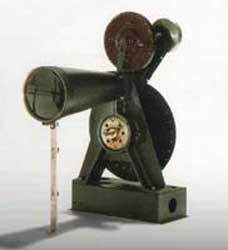
The first commercial “modern” TV circa 1940. The image was reflected off of a mirror at the top.

Meanwhile, this is considered to be the first commerically available TV of any sort.
HISTORY of TV — Here are a few fantastic resources and websites with all sorts of cool photos, and a complete history of TV as it evolved from its first invention. This stuff will keep you busy for hours since most of us were taught very little about the true history of TV.
This is interesting material if only to use as a template with which to judge current technologies and trends.
This section provides cover scans of the popular hobbyist magazines leading up to the launch of television, not only in the United States, but also England and France.
The Definitive Site for Mechanical TV and early Television
History of the Scanning Disk Televisor on Early Television.org

The first mechanical television systems were developed by John Logie Baird in England and by Charles Jenkins in the U.S. in the mid 20s.
Picture quality was very poor, and the screens were only an inch or so wide and were made up of only 30 to 60 lines (compared to 525 lines in the present U.S. system). These sets used a motor to rotate a metal disk to produce the picture, rather than a picture tube. A neon tube behind the disk provided the light.
By 1930, television was being broadcast from over a dozen stations in the U.S., not only from the major cities such as New York and Boston, but also from Iowa and Kansas. Several manufacturers were selling sets and kits.
The frequencies used for TV broadcasting at that time could travel long distances, so reception was possible hundreds of miles from the station. However, the pictures suffered from not only poor resolution, but also fading and ghosting.

Kuba Komet

Earliest of French Scanning Disk Televisors
A British Site Detailing the important UK History.

Proposal to do a “modern”
Baird Televisor














